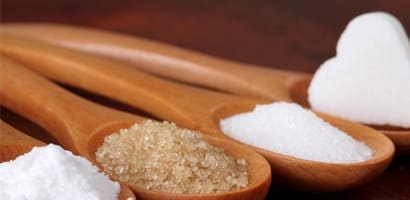
Sugar is a simple carbohydrate that provides calories for your body to use as energy. There are two main types:
Natural sugar is found in whole, unprocessed foods. These include fruit, vegetables, dairy, and some grains. Fructose is a natural sugar found in fruit. Lactose is a natural sugar found in animal dairy products.
Added sugar is found in processed foods and drinks. It also includes sugar you add to foods at home. Added sugar provides little to no nutritional value. It’s used for different reasons, such as:
- To keep baked goods fresh longer
- To keep jellies and jams from spoiling
- To help fermentation in breads and alcohol
- To improve the flavor, color, or texture of foods and drinks
Foods that contain added sugar:
- Candy
- Cakes
- Cookies
- Pies and cobblers
- Sweet rolls, pastries, and doughnuts
- Dairy desserts, such as ice cream and yogurt
- Sweetened drinks, such as soft drinks, sports drinks, energy drinks, and juice drinks
Many Americans love sugar—and way too much of it. However, you should limit your added sugar to no more 10% of your total daily calories. That’s just 200 calories a day based on a 2,000 calorie per day diet. That translates into no more than 50 grams of sugar per day.
Path to improved health
Potential health problems from excess added sugar
If you eat or drink too much added sugar, it can lead to health problems. These include:
- Tooth decay
- Obesity
- Type 2 diabetes
- Heart disease
- High triglyceride levels
- Increased low-density lipoprotein (LDL, or “bad”) cholesterol levels
- Decreased high-density lipoprotein (HDL, or “good”) cholesterol levels
Added sugar in drinks
People who fill up on foods and drinks that contain added sugar may be less likely to eat and drink healthy options. For example, milk contains natural sugar but also provides calcium, protein, and vitamins that help your body function well. Sugary drinks contain added sugar and provide little to no nutritional value to your body.
Your body needs a certain amount of calories each day for energy. Think of this as your daily calorie goal. Your goal depends on your age, height, weight, and level of activity. Most of the calories you eat and drink should provide nutrients. Since added sugars don’t have much nutritional value, they’re called “empty calories.” You may gain weight if you eat or drink too many empty calories.
Things to consider
There are a lot of ways to limit or avoid added sugar in your diet.
- Choose heart-healthy foods, such as fruits, vegetables, lean proteins, and whole grains for meals and snacks.
- Cut out candy, baked goods, and dairy desserts.
- Opt for water over sugary drinks. A 12-ounce can of regular (non-diet) soda contains about 130 calories and 8 or more teaspoons of sugar. Also, pass on the juice, which is loaded with calories. Juice is not a substitute for real fruit and veggies.
- Cut out processed foods. These are high in added sugar and sodium.
- Look for recipes that use less sugar when you’re cooking or baking.
It’s important to read the nutrition facts label when purchasing food. Check to see how much sugar is in a product. One gram of sugar equals 4 calories, and 4 grams equals 1 teaspoon of sugar. As an example, if a label says 40 grams of sugar, you’re consuming 160 calories and 10 teaspoons of sugar per serving of that food. That’s a lot! So the lower the amount of added sugars, the better. As a general rule, foods with less than 5% added sugar make a good choice. Foods with more than 20% added sugars should be avoided.
The nutrition facts label also tells you the ingredients in food. Sugar can have many names. Some examples include:
- Syrup (many different kinds)
- Brown sugar
- Honey
- Molasses
- Fruit juice concentrates
- Dextrose
- Fructose
- Glucose
- Sucrose
The American Academy of Family Physicians supports taxation of sugar sweetened beverages for the purpose of reducing over-consumption as a method of both improving the health of the public and combating the obesity epidemic.
Questions to ask your doctor
- How many calories should I eat in a day?
- How much added sugar is too much?
- Are there ways to substitute natural sugar for added sugar when cooking or baking?
- What should I eat if I want a sweet snack?
Resources
National Institute of Health, MedlinePlus: Sweeteners – Sugars
U.S. Food & Drug Administration: Interactive Nutrition Facts Label: Total and Added Sugars
![]()
Copyright © American Academy of Family Physicians
This information provides a general overview and may not apply to everyone. Talk to your family doctor to find out if this information applies to you and to get more information on this subject.




